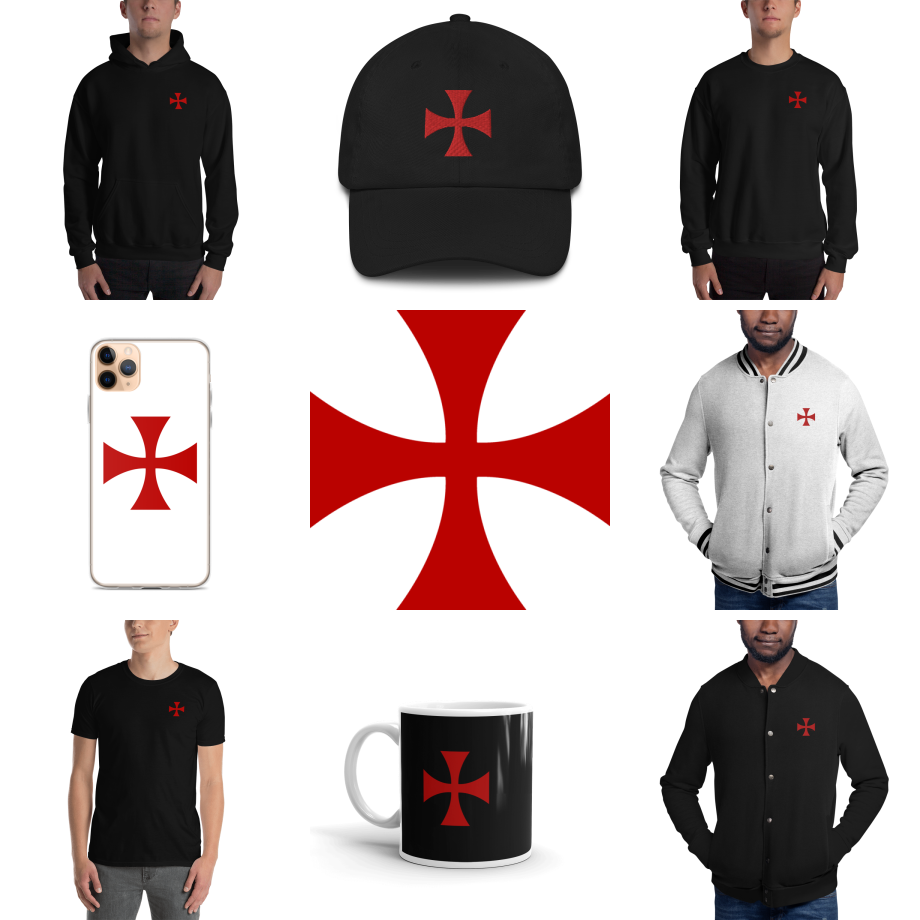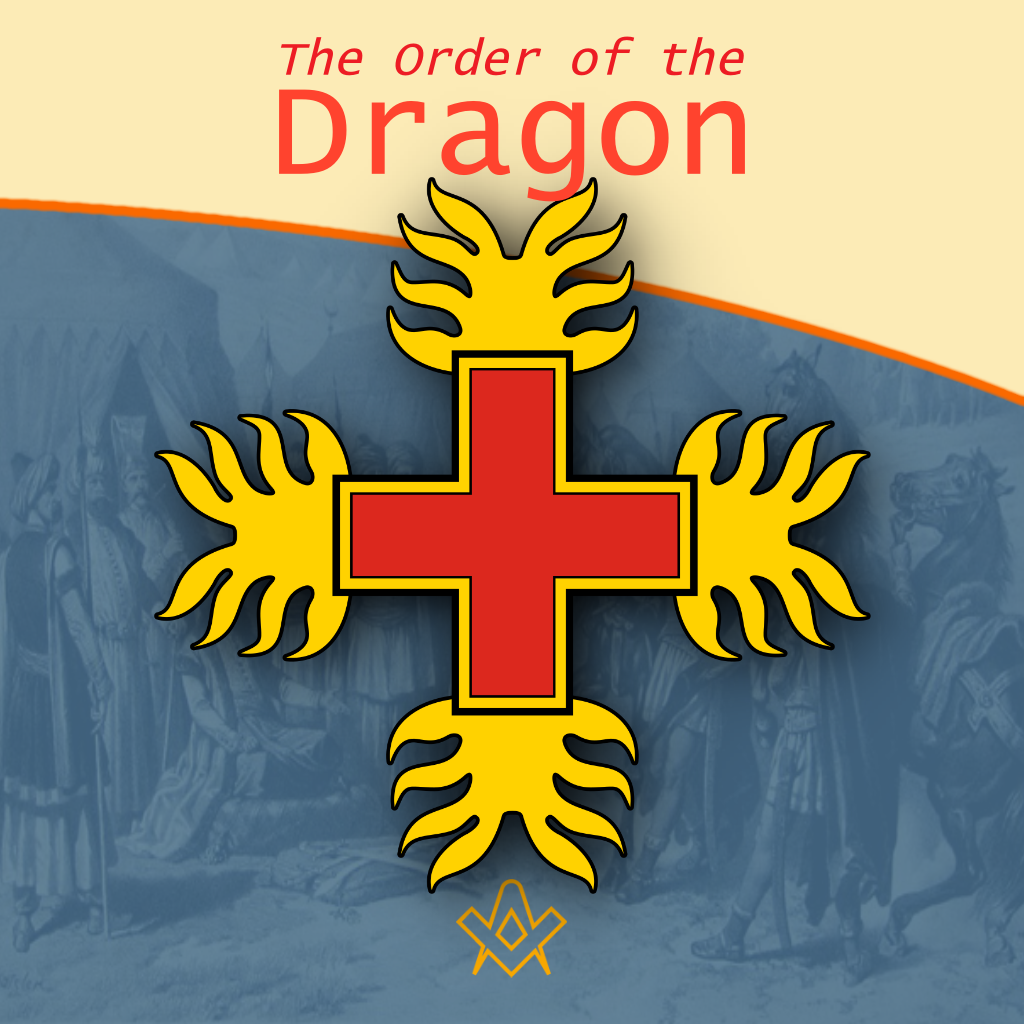The Order of the Dragon – Societas Draconistarum, meaning “Society of the Dragonists”– was a chivalric Order for selected nobility, founded in 1408 by Sigismund von Luxembourg, who through marriage became the King of Hungary (1387–1437) and later Holy Roman Emperor.
The Order was fashioned after the military orders of the Crusades, requiring its initiates to defend the cross and fight the enemies of Christianity, in particular the Ottoman Empire.
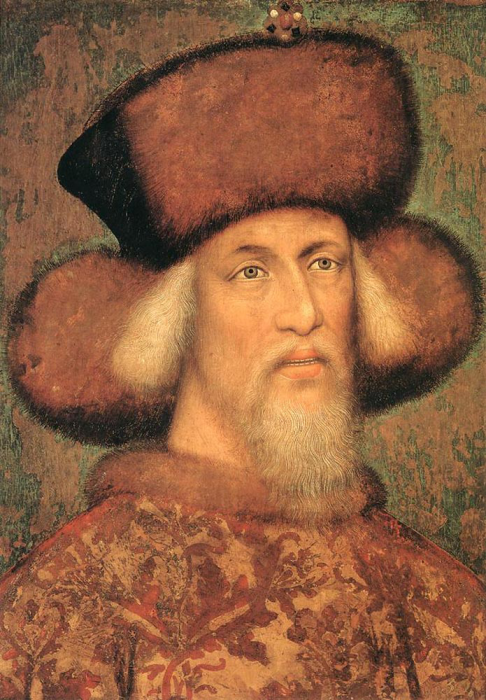
Sigismund von Luxembourg, King of Hungary and Holy Roman Emperor.
IMAGE LINKED: wikimedia Attribution 4.0 International (CC BY 4.0)
The Order flourished during the first half of the 15th century, primarily in Germany and Italy.
After Sigismund’s death in 1437, its importance declined in Western Europe, but it continued to play a role in Hungary, Croatia, Albania, Serbia and Romania which bore the brunt of the Ottoman incursions.
The Order’s statutes, written in Latin, call it a societas (society) whose members carry the signum draconis (a dragon).
The members were mostly Sigismund’s political allies and supporters, who were at first largely associated with the ruler of Serbia, Prince Stefan Lazarević
The twenty-one original members of the Order were named one by one in the founding charters.
To mention a few, Stefan Lazarević, Hermann II, Count of Celje, Stiborius de Stiboricz Voivode of Transylvania, and so on. As the Order grew, it expanded to two degrees: first degree of superior class and second degree members.
Some of the later members were the brother of the Serbian Prince, Fruhzin, the son of Tsar Ivan of Bulgaria, King Henry V of England, Vlad II Dracul, Vlad III Dracula The Impaler, King Alfonso the Magnanimous of Aragon and others.
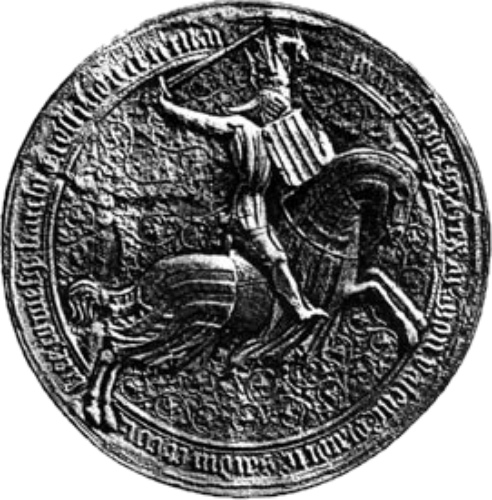
Seal of King of Aragon displaying the dragon helmet
IMAGE LINKED: wikimedia Attribution 4.0 International (CC BY 4.0)
The edict of 1408 describes two insignia to be worn by members of the Order:
…we and the faithful barons and magnates of our kingdom shall bear and have, and do choose and agree to wear and bear, in the manner of society, the sign or effigy of the Dragon incurved into the form of a circle, its tail winding around its neck, divided through the middle of its back along its length from the top of its head right to the tip of its tail, with blood forming a red crossflowing out into the interior of the cleft by a white crack, untouched by blood…
The official coat of arms depicts the biblical beast, the dragon with its tail coiled around its neck, that bears comparison to the ouroboros, which is an ancient symbol depicting a serpent or dragon eating its own tail.
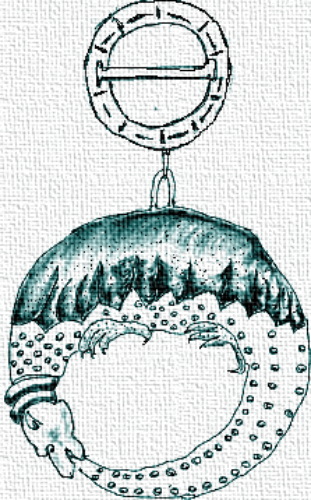
Reconstruction of the emblem (II) based on the sketches in Austrian Museum custody; the original badge is missing.
IMAGE LINKED: wikimedia Attribution 4.0 International (CC BY 4.0)
The Dragon represents the Beast of Revelation who is slain by the forces of good. There is no original form of the emblem that has survived, but it has been referenced on coins, art and in writing.
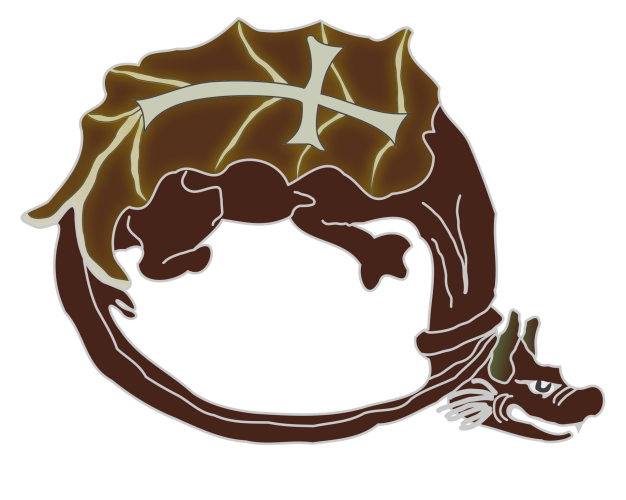
Order of the Dragon Insignia. Reconstruction of the order patch (I) based on existing Austrian museum artifacts.
IMAGE LINKED: wikimedia Attribution 4.0 International (CC BY 4.0)
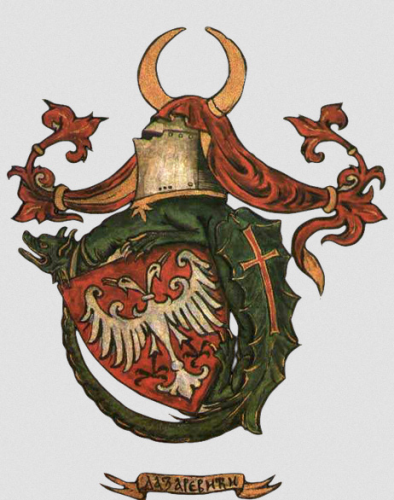
Coat of Arms of Prince Stefan Lazarevich depicting the dragon as described by the Order
IMAGE LINKED: wikimedia Attribution 4.0 International (CC BY 4.0)
The official Cross of the Order is a Red Cross, with yellow flames at the end of each arm of the cross.
It is taught that each of the fiery flames of the cross represents virtues, obligations or aspirations of the knights, similar to those later found on the eight points of the Maltese Cross.
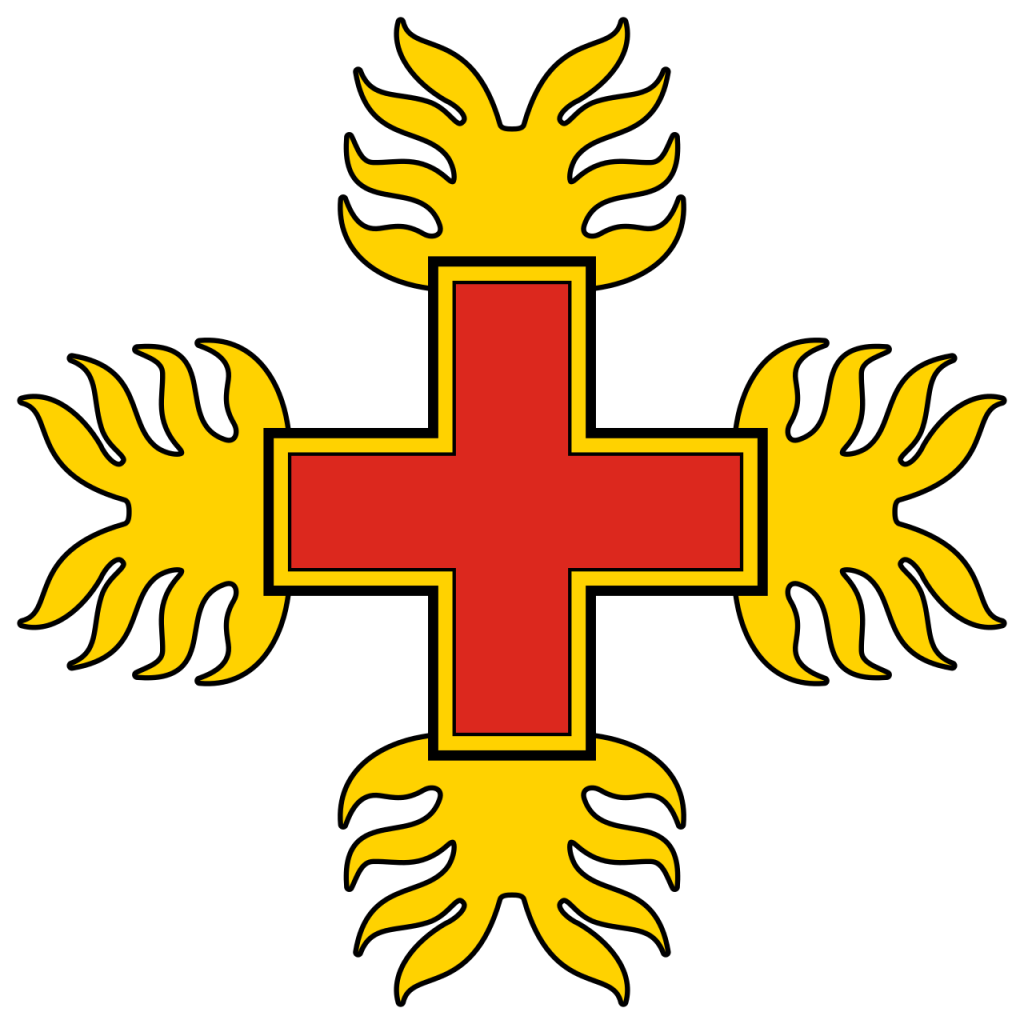
The official Cross insignia of the Order of the Dragon
IMAGE LINKED: wikimedia Attribution 4.0 International (CC BY 4.0)
Although founded in 1408 by King Sigismund, some evidence points to the existence of the Order of the Dragon to an earlier period. Looking further back into the history when the Ottoman Empire was pushing deeper into Balkans and Christian Europe we find that Turkish raiding party, passing unobstructed through territories broke into Moravian Serbia in 1381.
The Ottoman army penetrated Serbia and neighbouring areas, killing and looting, then clashed with the subjects of Serbian ruler Tsar Lazar (father of Prince Stefan Lazarevich) at Dubravnica, where they were successfully fought off.
With a larger force, the Ottoman Sultan Murad I attacked Serbia in 1386 where the two armies fought at the battle of Plochnik.
The Serbian army emerged victorious. More than 60% of the Ottoman army was destroyed. According to the tradition, Serbian knight and folk hero Miloš Obilić participated in this battle where he distinguished himself.
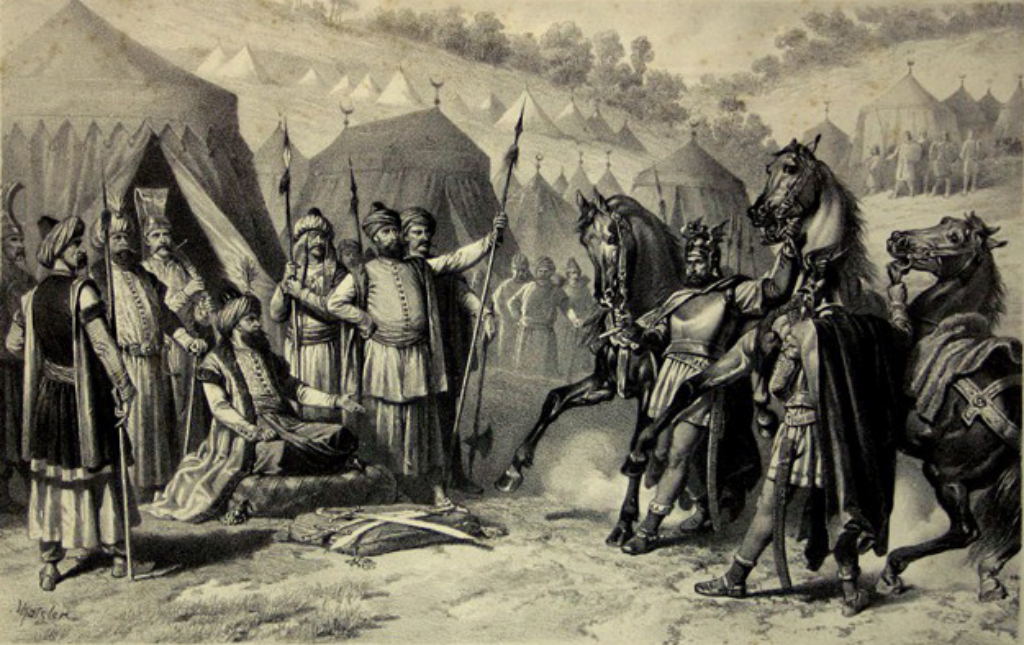
Miloš Obilić at the tent of Sultan Murad.
IMAGE LINKED: wikimedia Attribution 4.0 International (CC BY 4.0)
At a later date a much bigger and decisive battle between the two armies took place at the Battle of Kosovo in year of 1389. Sultan Murad I with his Ottoman army on one side, Tsar Lazar with the Serbian army on the other.
In the battle both sides suffered great losses and both leaders lost their lives. It is said that twelve Serbian knights were given order to kill Sultan by any means.
The death of the Sultan is widely attributed to Miloš Obilić.
After the battle, in a letter from the Florentine senate written by Coluccio Salutati dated 20th October 1389, Sultan Murad’s killing was described:
“Fortunate, most fortunate are those hands of the twelve loyal lords who, having opened their way with the sword and having penetrated the enemy lines and the circle of chained camels, heroically reached the tent of Amurat (Murad) himself. Fortunate above all is that one who so forcefully killed such a strong leader by stabbing him with a sword in the throat and belly.”
There are many stories surrounding the battle triumphs of those knights, particularly of Miloš Obilić.
Folk songs singing his praise in one song, it is said
“…your father is the dragon of the sky”
and
“…mother Yana conceived him with a dragon”,
or
“…from the dragon he inherited the mark”.
Many references describe him as the son of the dragon.
This is quite similar in the case of well known Romanian ruler Vlad III, the Impaler, also known as Lord Dracula.
His father Vlad II, as one of the first members of Sigismund’s Order of the Dragon became known as Vlad “Dracul” (Dracul meaning Dragon); hence Vlad III is also famous as “Dracula”, meaning the “Son of the Dragon”.
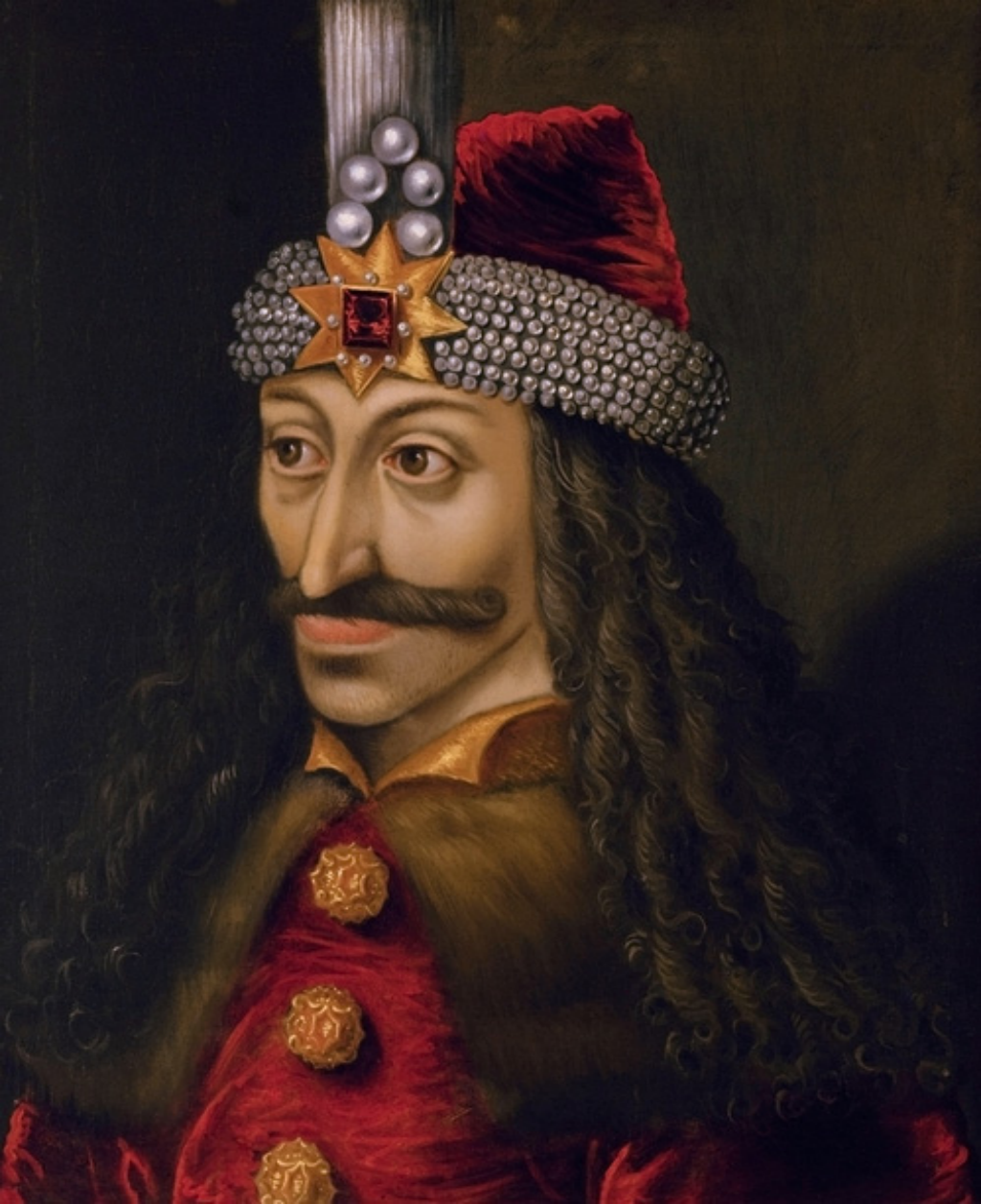
Vlad III, The Impaler, Dracula – the Son of the Dragon
IMAGE LINKED: wikimedia Attribution 4.0 International (CC BY 4.0)
Is it safe to conclude that Miloš Obilić who is continuously referred to as the ‘son of a dragon’ could be a dragon himself?
Do we then also consider the possibility that the Order perhaps existed earlier than its official date when founded by King Sigismund?
Serbian folk songs do not sing only of knight Miloš but also of other knights, suggesting their link to an Order through the lineage of their fathers, the Dragons.
|
Moj Miloshe, moje milovanye, Stho goj ima Srbina yunaka. Svakoga su odgoyile vile, mlogoga su zmayevi podigli. Svakog chu ti po imenu kazat: Evo prvog tebe, Obilichu, a drugoga Zmay-ognyenog Vuka, a tretchega Relyu Boshnyanina, zmayeva ye i on porodica. A chetvrtog Banovich Sekulu, i nyemu ye zmay ognyeni. A petoga Banovich Strahila, i nyemu ye zmaj ognyeni babo. A shestoga Lyutitzu Bogdana, i nyemu ye zmaj ognyeni babo. A sedmoga Kralyevicha Marka, i nyemu ye zmaj ognyeni babo. Svaki ima zmayevu biljegu. |
My Milosh, my fondness, what a hero Serb is. Everyone has been raised by maidens, though many were born of dragons. I shall name each by his name: Here is you first, Milosh Obilich, and the second fiery-dragon Vuk, and the third Relya Boshnyanin, he is of the dragon family. And the fourth Banovich Sekula, he as well is of dragon fiery. And the fifth Banovich Strahil, and to him the father is fiery dragon. And the sixth Lyutitza Bogdan, and to him the father is fiery dragon. And the seventh Prince Marko, and to him the father is fiery dragon. Each of you bear the mark of the dragon. |
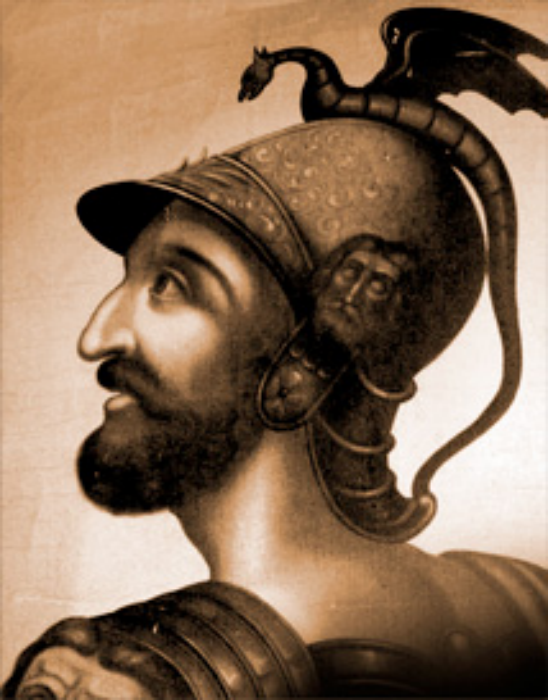
Miloš Obilić, oil painting, c. 1900, by Vladislav Titelbah. National Museum of Kikinda.
IMAGE LINKED: wikimedia Attribution 4.0 International (CC BY 4.0)
The oral tradition in many instances refers to the mark that the dragons and sons of dragons are in possession.
The mark that is often mentioned is considered to be the mark of the dragon that members wore about their body as the insignia on their armour, shield and helmet or even as some form of tattoo on their skin.
“Svaki ima zmayevu bilyegu“
Each of you bear the sign of the dragon
“Od zmaya je nasledio mladezh“
From the dragon he inherited the mark
“Zavrati mu uz ruke rukave, nach chesh nyemu mladezh na mishici“
Pull up his arm slieves, you shall find the mark on his muscle
“Druga mu je na nozi bilyega”
Second is the sign on his leg
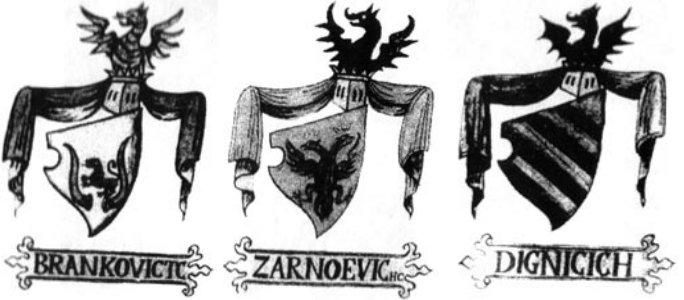
The coats of arms of the knights: Branković, Zarnoevich, and Dignichich
IMAGE LINKED: wikimedia Attribution 4.0 International (CC BY 4.0)
As we look for the answers, we find ourselves finding more questions. In the case of the Order of the Dragon, there are many more questions to be asked.
What is not written on the paper or brush-painted onto the canvas can sometimes be still stored in the oral folklore.
If the fathers of those Serbian ‘Knights as Dragons’ might have been the members of some version of the Dragon Order, can we speculate that the fathers of their fathers, and the fathers of their fathers before them could have been the ‘Dragons’ themselves?
Article by: Alex Lishanin


Transylvania – Order of the Dragon
By: J. Rife
This exciting new edition includes photographs as author and photographer J. Rife tells the story of Vlad Dracula as you’ve never heard before.
Rising from the ashes of Ottoman oppression, a true son of Transylvania battles for honor, for freedom, and even for love.
This true retelling of the legend will forever change how we see whom writers of history call a villain, yet the people of his homeland hail as a hero. Step inside this journey through time to meet a hero of ages past.

Dracula: Prince of Many Faces
By: Radu R. Florescu and Raymond T. McNally
A biography of the real 15th-century Wallachian leader known as Vlad the Impaler, who inspired the classic horror novel by Bram Stoker.
Dreaded by his enemies, emulated by later rulers like Ivan the Terrible, honored by his countrymen even today, Vlad Dracula was surely one of the most intriguing figures to have stalked the corridors of European and Asian capitals in the fifteenth century.
Vlad Dracula also served as the inspiration for Bram Stoker’s classic vampire tale. However, as this biography proves, “the real Dracula is far more interesting than the fictional vampire” (Houston Chronicle). Covering Vlad Dracula’s entire life and subsequent legend, this book includes “a fascinating chapter on the mystery of Dracula’s empty grave” (New York Times Book Review).
Praise for Dracula, Prince of Many Faces
“Florescu and McNally manage to capture the ruthlessness, romance, and courage that characterized Dracula’s ultimately pitiable life. . . . A fascinating look at political intrigue in fifteenth-century Eastern Europe.” —Lamar B. Graham, Boston Phoenix Literary Supplement
Recent Articles: masonic history
 Protestantism and Masonic Influence in Brazil Discover the untold story of how Freemasons helped Southern Americans immigrate to Brazil post-Civil War, fostering economic and educational growth in Santa Bárbara d’Oeste and Americana. Learn about their pivotal role in establishing Protestant churches and ensuring the secularity of the Brazilian State amidst a Catholic-dominated society. |
 Explore the proper use of the sacred word in Brazilian Freemasonry through an analysis of Masonic literature and Bible translations. Uncover the errors in pronunciation and the need for corrections to maintain liturgical coherence in rituals. Discover insights on Masonry, rituals, and the Hebrew word Boaz. |
 Narratives of History |
 A Very Royal Sesquicentenary |
 Unveiling the Enigma: Discover the Royal Society's Legacy and its Impact on Science. Delve into the fascinating history of the Royal Society, the prestigious UK academy shaping scientific progress since 1660. Explore its pivotal role in advancing knowledge, fostering collaboration, and unlocking the secrets of the universe. Prepare to be amazed! |
 Knights Templar in Freemasonry Uncover the Mysteries of the Knights Templar in Freemasonry! Delve into the intriguing world where chivalry and symbolism intertwine. Discover the captivating rituals and ancient secrets behind the Knights Templar Masonic Orders. Explore the historical connection and delve into the enigmatic narratives that continue to fascinate enthusiasts today. Unveil the hidden truths now! |
 The Royal Arch stands as the rainbow of promise in the Ritual; it stands as the promise of the resurrection; of that which was lost and that it shall be recovered. The question arises as to whether the Master's Word was originally communicated in the Third Degree? On this point there is some diversity of opinion. Originally published in 1915, this insight into the Fourth Degree – the Holy Royal Arch – is as relevant today as it was over 100 years ago. |
 Unveiling the Mysteries of Druidism: Discover the Intriguing Connection with Freemasonry. Explore the ancient spiritual practice of Druidism and its fascinating ties to the enigmatic world of Freemasonry. Delve into the shared symbolism and rituals that have captivated minds for centuries. Unlock the secrets of these intertwined traditions today! |
 Uncover the legacy of freestone masons and their pivotal role in crafting medieval cathedrals. Discover the artistry behind their techniques, the hierarchy within their craft, and the enduring impact of their intricate carvings. A deep dive into the world of these master craftsmen awaits you! |
 Unearth the intriguing journey from Vincha Culture to Freemasonry. Discover how ancient building methods intertwine with modern Masonic philosophies. This exploration will shed light on the fascinating link between the Serbian term "shestarenye" and the symbolic significance of the compass in Freemasonry. |
 Freemasonry and the Illuminati Unravel the enigmatic world of Freemasonry and the Illuminati in our latest exposé. Dive into centuries-old mysteries, debunk conspiracy theories, and discover the truth behind these elusive societies. Are they puppet masters or mere myths? Join us as we dissect history and fact from fiction. |
 The Île des Templiers, or “Island of the Templars” lies within a leafy park in Paris. The execution site of Jacques du Molay, the last Grand Master of the Knights’ Templar bears a plaque with the epitaph ‘A cet endroit / Jacques de Molay / Dernier grand maître / de l'ordre du temple / a été brûlé le 18 Mars 1314’ (‘In this location / Jacques de Molay / Last grand master / of the order of the temple / was burned on 18 March 1314’) |
 Operative Progressions to Speculative Masonry Both Operative and Speculative Masonry are an important part of the modern fraternity of Freemasonry, which combines elements of both traditions. Today, Freemasonry is a fraternity that is open to men of good character, who are interested in personal development and in making a positive contribution to their communities. |
 General Regulations of a Free Mason, 1723 General Regulations of a Free Mason as contained in Anderson's Constitutions of the Freemasons, published 1723. the Regulations are of great historical interest. Compiled by George Payne, the second Grand Master of the Premier Grand Lodge of England, they were printed in 1722/3, thus published just over five years after the formation of the Grand Lodge 1717. |
 The Genesis of the 1723 Book of Constitutions 2023, marks the three hundredth anniversary of the publication of the first printed Book of Constitutions of the Grand Lodge formally established in London two years previously. This is an anniversary whose significance extends beyond freemasonry. A paper by Andrew Prescott |
 The Ritual of the Operative Free Masons - P3 Existing Operative Free Masons. The ritual I am about to refer, is that of "The Worshipful Society of Free Masons, Rough Masons, Wallers, Slaters, Paviors, Plaisterers, and Bricklayers." By Thomas Carr, M.D., P. M. Honorary Member of the Guild of Operative Free Masons |
 Liberté chérie was a Masonic Lodge founded in 1943 by Belgian Resistance fighters and other political prisoners at Esterwegen concentration camp. It was one of the few lodges of Freemasons founded within a Nazi concentration camp during the Second World War. |
 The Ritual of the Operative Free Masons - P2 If anyone doubts the fact that the formation of Speculative Free Masonry was due to and based upon Operative Free Masonry, it is quite easy to convince him of his error if he will only study the first Book of Constitutions. By Thomas Carr, M.D., P. M. Honorary Member of the Guild of Operative Free Masons |
 In 1881, Freemasonry rose from the ashes of a fire in the mining town of Kokomo, Summit County, Colorado. Corinthian Lodge No. 42, along with Kokomo, no longer exists but it holds the record of having been – at an elevation of 10,618 feet – the highest Masonic Lodge in the USA. |
 The Huguenots and Early Modern Freemasonry The Huguenots influence in the development of early modern Freemasonry at the time of the formation of the Grand Lodge in London around 1717 / 1723. |
 November is a month of reflection – perhaps due to the fact that we are getting close to the years' end – but also because Remembrance / Armistice Day (11 November) is a significant date in most countries' diaries. |
 Speculative Freemasonry, as practise by Grand Lodge of England, was officially born just over three hundred years ago, is today an international organisation, counting over six million members. It has been subjected to persecution, suppression, and abolition throughout its history. In its infancy, only a couple of decades after its official birth, it had already become a target. |
 The Ritual of the Operative Free Masons - P1 The original paper was written, first, to prove that Speculative Free Masonry was derived from Operative Free Masonry; second, to give some account of the Operative Free Masons, of their Ritual, and of their customs. By Thomas Carr, M.D., P. M. Honorary Member of the Guild of Operative Free Masons |
 American Fraternalism in the 19th and Early 20th Centuries The late 19th and early 20th centuries in the United States has been called the "Golden Age of Fraternalism." How did this come about and why was the idea of joining a fraternal organization so popular? We will explore this question and examine the regalia used by many fraternal organizations in this period. |
 Societas Draconistarum, meaning "Society of the Dragonists"– was a chivalric Order for selected nobility, founded in 1408 by Sigismund von Luxembourg, who through marriage became the King of Hungary (1387–1437) and later Holy Roman Emperor. The Order was fashioned after the military orders of the Crusades, requiring its initiates to defend the cross and fight the enemies of Christianity, in particular the Ottoman Empire. |
 The Perjured Free Mason Detected Was Samuel Prichard a perjured individual, or simply a misguided Freemason? Prichard's book "Free Masonry Dissected" published in 1730, is now used by many Masonic historians as a source of reference with regards to the introduction of the third degree into the Craft. But at the time it was published in 1730, it was not so well received by members of the Grand Lodge of England. |
 17th century and the Holy Royal Arch This article focuses on a period of transition between a point in time when we can safely and historically identify the first formation of what could be called as the ‘Royal Arch’ and the historical events that have preceded it. |
 Most Freemasons have heard the terms 'Operative' and 'Speculative' Masons, and this article helps to understand the difference: |
 Roberts' Constitutions of Freemasonry 1722 Published a year before Anderson's Constitutions, The Old Constitutions Belonging to the Ancient and Honourable SOCIETY OF Free and Accepted MASONS. Originally printed in London England; Sold by J. Roberts, in Warwick-Lane, MDCCXXII.(1722) |
 From 'Songs of religion and life', 1876 by John Stuart Blackie (1809-1895) |
 On the Antiquity of Masonic Symbolism Is the Symbolism of Masonry an inheritance derived from the old Masons who flourished before the era of the Grand Lodges (1717); or has it been borrowed from the Rosicrucians or others, after 1717? |
 Mason's Marks – from Egypt to Europe? Mason's marks have been a source of intrigue, not only to Freemasons but to historians and archaeologists. The use of simple pictograms have been employed for millennia by artisans to identify their work. But where did they originate and why? |
 The White House Foundation Stones Further to the articles in our series on the history of the stone masons, we have a rather intriguing addition. During the 1950's renovation of the White House, President Truman retrieved more than 100 stone blocks with stonemasons marks. |
 What the Goose and Gridiron Tavern is in the ancient annals of London Freemasonry, The Green Dragon Tavern is to the memories of the Free-mason, of Boston and New England. |
 Auschwitz concentration camp: video photo article taken in 2013 |
 There are two things of importance happening this day - 27 January |
 Two approaches regarding the understanding of Freemasonry |
 Masonic Research in England c1930 An article which appeared in an American Masonic magazine, c1930 and which was reproduced in England, provoking a little controversy. |
 Masonic bookplates the ‘Brethren’s spiritual coats of arms and marks’ |
 The Unlawful Societies Act of 1799 Rebellious Freemasons and the 21st century |
 In 1912, Sarah Dowd of Dromore, Ireland, found a Masonic jewel dated 1517 - a date two hundred years before the establishment of Grand Lodge... |
 Freemasonry and Fascist Regime Interesting speech by the famous historian Prof. Aldo A. Mola, who links the fascist regime with the Masonic Associations. |
 Was famous Russian poet Alexander Pushkin a Freemason? And if so, was he a member of the lodge ‘for which all the lodges in Russia were destroyed’? |
 The Importance of Masonic Research Why is accurate - or authentic - Masonic research so important? The importance of making a daily advancement in Masonic knowledge is something that The Square is passionate about promoting. |
 The Antient Noble Order of the Gormogons had a brief existence in the eighteenth century; they left few records or accomplishments, |
masonic knowledge
to be a better citizen of the world
share the square with two brothers

click image to open email app on mobile device
